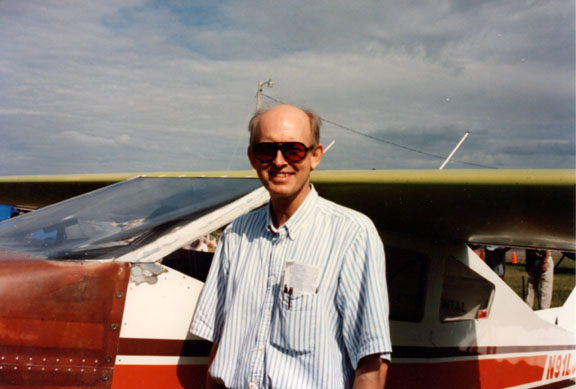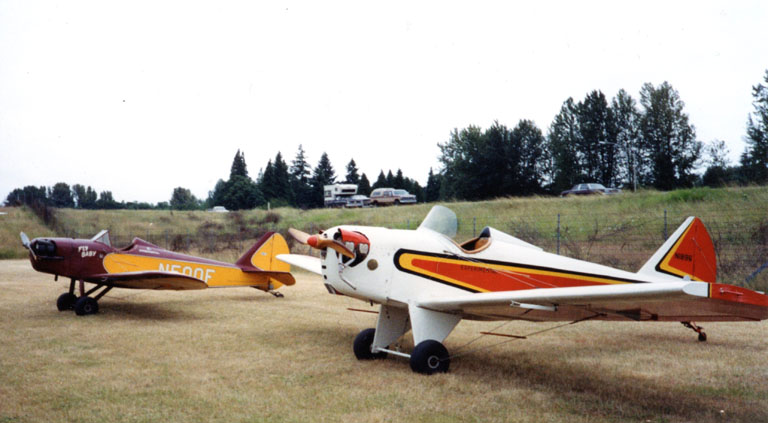
It began in the oddest way. One Monday, I got a worried call from the program officer of my EAA chapter. Their regular program had fallen through; could I put together a slide show for that evening?
So after work, I sat on the couch with my slide pages and a portable light table, sifting through my batch of Oshkosh '92 slides for things I hadn't shown before. I wasn't looking for details on the slides; I was just scanning for the familiar shapes that would remind me of what the slide actually looked like.
One caught my eye. I knew what it was. I lifted the light table closer. In the picture was a balding man with a big grin, in front of a mottled brown-and-white homebuilt.
At that moment, I realized: I'd never told John goodbye.

I remembered the first time we'd flown together. It was to a computer-users Fly-In about a hundred miles from the airport where we kept our Fly Babies. John, a fellow EAA chapter member, had just flown the hours off his airplane and I suggested we fly down together.
According to Pete Bowers, John was about the tallest person ever to fly a 'Baby. He'd had to drop the floor down slightly to give him enough room to work the rudders and brakes.
The day of the fly-in was severe clear, with just a little high cirrus. John took off first. His A-65 was running a bit rich, leaving a faint black smoke trail. I remember swishing back and forth behind him, "strafing the flaming hun", before joining up to catch a 150-Watt grin flashing from the incongruously tall figure in the cockpit. We had an uneventful flight, had a wonderful lunch, and winged our way home.

It'd be the easiest thing in the world to claim we were inseperable from that point. But our interests soon split. He had a family, including a young son who wanted to fly with him. Soon John had a Tri-Pacer. I kidded him unmercifully, of course. I rode with him a few times and we saw each other at the EAA meetings. We never "pal'ed" around, but I was always glad to meet him. And, judging from his everpresent grin, he was happy as well.
Finally, he decided the Piper was too slow. It was a BD-4 he needed; fast with enough room for a couple of kids. He found a partially completed kit and started to work. I then saw him even less.
The announcement at the January 1992 EAA meeting, then, was a shocker. John had cancer. Terminal, and given the near-cliche'd six months to live.
He had one wish: To finish his BD-4 and fly it to Oshkosh.
His friend Roger Mellema, the local BD-4 guru, took up the gauntlet. They set John's project up in Roger's immense hangar. When treatments allowed, John worked on the plane. Other BD-4 owners and builders pitched in.
They made it with three weeks to spare. John made the first flight, pronouncing the plane near-perfect. They quickly eliminated the bugs and flew off the 25 hours. They didn't have enough time to paint it, unfortunately. The BD had used some parts from a previously-flying aircraft, and combined with the bare or primed aluminum and raw fiberglass was a bit hard on the eyes.
No matter, though. John flew his son to Oshkosh. I met him there; the grin, if anything, even wider. I took his picture to prove to the world he'd flown to Oshkosh in his own homebuilt airplane. He was bright and chipper, if a little thinner than I remembered. And just plain overjoyed to be there.
John arrived early, and got a good parking space. I took to taking a break from the insanity and from the sun by stretching out in the shade of his long fiberglass wing. I could hear people talking, as they took in the piebald airplane: "Got into a rush with this one." "Geeze, why didn't he wait a year and bring a good-looking plane." John probably heard them, too. But I don't think he minded.
After Oshkosh... well, John turned worse. The Seattle chapter is pretty big; I don't think that many people knew him to start with.
At the 1992 chapter Christmas party, I happened to sit at the same table as Roger. Our chapter awards first-flight jackets to its members. Roger had said earlier that John was going to try make the party, to get his jacket, if nothing else.
John wasn't there. "How is he?" I asked Roger.
"Not good," came the grim reply. The treatments kept him groggy and weak. He couldn't make it up the stairs at home, so his family had installed his hospital bed in the living room. The disease made him frail. He'd broken ribs simply by coughing.
So when the chapter president called John's name, Roger stood and walked to the front of the room. He gently took the jacket. "How's John?" the president asked.
Roger started to respond. But words seem to catch in his throat. The burly ex-marine stared at the floor for a moment. Then he swallowed, shook his head, and walked back to his seat.
From that point on, I expected the worst.
I didn't expect, though, the call I received four months later. John had somehow made it to the airport. He'd used his key to enter the hangar where his BD was kept. The door opened at a touch of a button.
John hadn't the strength or flexibility to pull the plane out the normal way. Instead, he swung the prop vertical, wrapped his emaciated arms around the blade, and slowly walked backwards, dragging the plane out with him. He climbed into the cockpit and took off into the bright spring afternoon.
I don't know what went through John's mind that day. Had he remembered fellow pilots saying, "I'd rather die at the controls than die by inches"? Did he think that he'd already beat the doctor's prediction by eight months? Did he think of the love of his family?
We'll never know.
All we know is John flew his homebuilt for about 45 minutes. Then he turned around, flew back to the airport, and landed.
And when he called me that evening, with his voice still bubbling with the thrill of flight--I didn't quite know what to think. Last I'd heard about him, he'd been practically on his deathbed. But here he was, laughing, talking about how clear Mount Rainier had been, and of watching the sailboats in Puget Sound. I'd just had my first pilot report published, of which I was inordinately proud, and John was most complimentary. He asked more about the airplane.
And about how hard I thought it would be to build.
That stopped me for a moment. "Uhhh... pretty easy, really."
"Good," said John. "The BD-4 wouldn't be the right plane for my boy to learn to fly in. I'm thinking of building a Maverick for him."
We talked of flying for a while longer, then said, "So long." I immediately called Roger. His voice, still tight with traces of anger at the chance his friend had taken, told the tale. He'd come home from work to find John's plane sitting outside. He had almost committed the perfect crime... but hadn't had enough strength left to drag the BD-4 back into the hangar.
Over a year after John's last flight, Roger stood up at our EAA meeting. "I'm selling a BD-4 for someone..." John had died two weeks earlier. He beat his doctor's "Six month" prediction by a factor of four.
I could get all maudlin here, and moan how the world is sadder for his passing. It's true... but that wasn't John. He was the grin from the open cockpit. The smiling face in the back row of the EAA meeting. The laughing voice, planning an airplane he knew he'd never have the chance to cut metal for.
Instead, I'll make it short.
Goodbye, John.
Comments? Contact Ron Wanttaja.